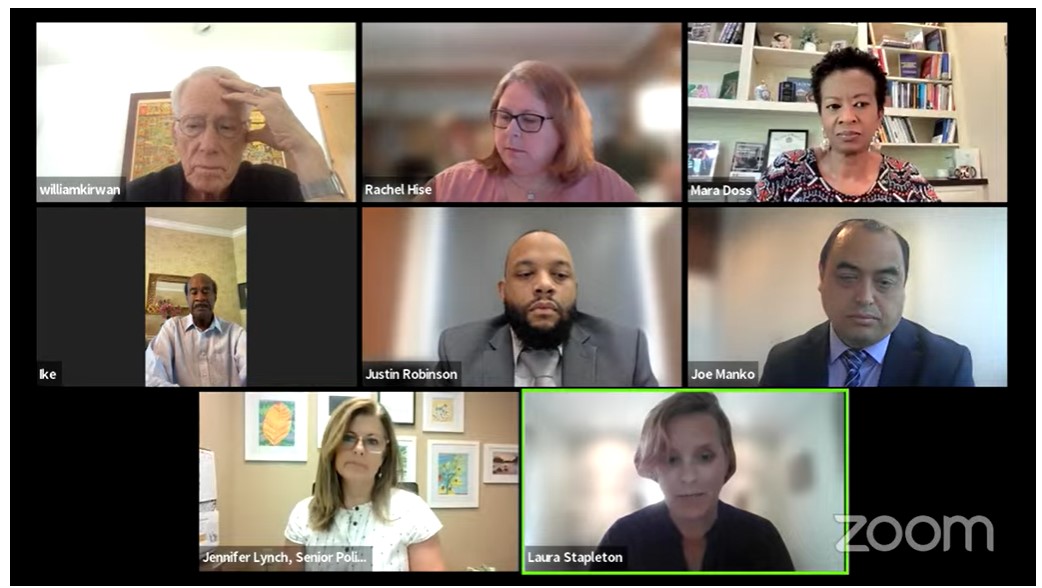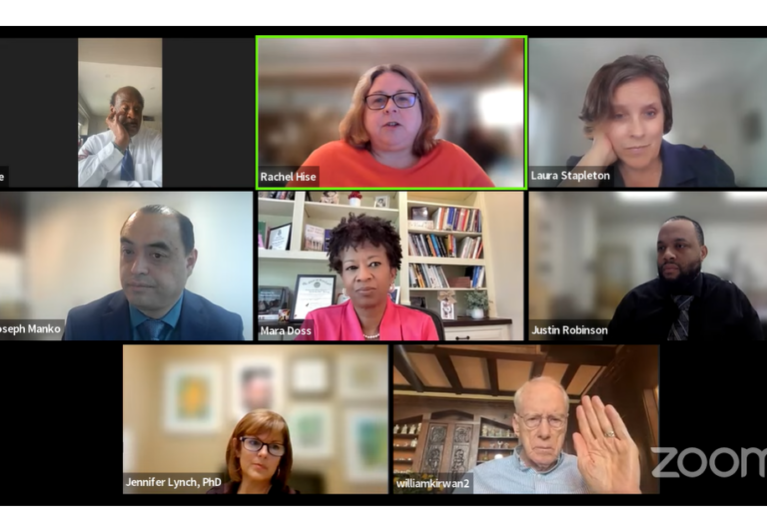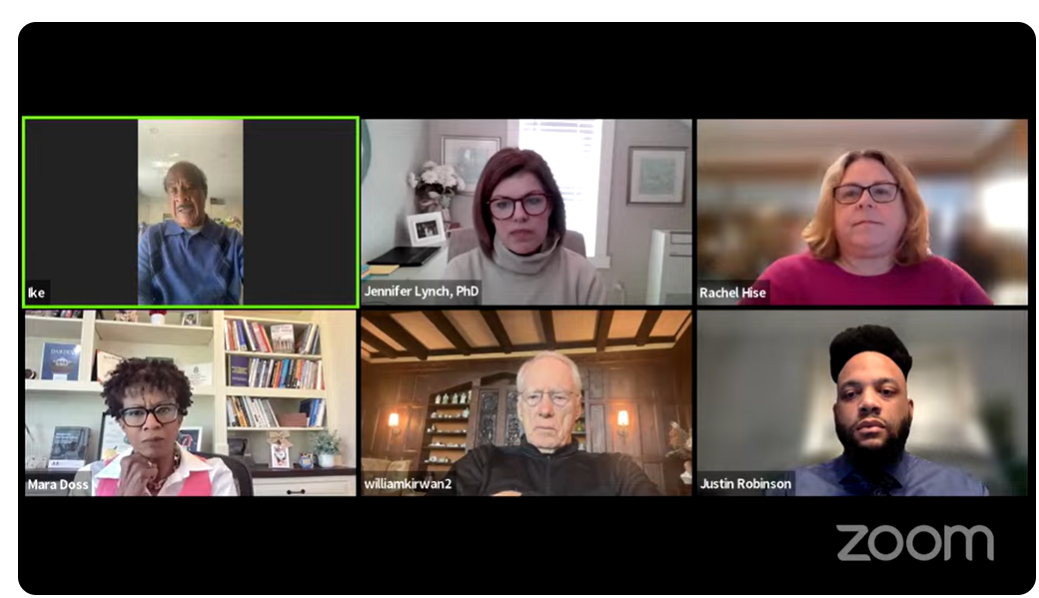Breaking down the Blueprint: Board approves updates to statewide reform plan, offers feedback to local school systems

The Blueprint for Maryland’s Future Accountability and Implementation Board has approved updates to the statewide comprehensive education reform plan, on schedule with a law that calls for the massive plan to be revised each year by Aug. 1.
Some changes the board made Tuesday were discussed July 20, such as requiring local health and social service agencies to share with local school systems the names and contact information of families with children who could be eligible to enroll in free prekindergarten.
This and other revisions — which were recommended by staff of the state Department of Education and other state agencies, as well as by local school leaders, parents and other stakeholders — focus on most of the Blueprint’s priorities: expanding early childhood education, hiring and retaining high-quality and diverse teachers, preparing students for college and technical careers and providing additional resources for students in need.
The other priority is governance and accountability for the Blueprint board, also known as the AIB, that was established by lawmakers to oversee the education reform plan until 2032. The board decided that, together with the Department of Education, they will develop a framework to identify areas of technical assistance that need to be provided to school systems and what agencies should provide it.
“I just feel like this process has worked extremely well and that we’ve been very open and accommodated the input that has come from a variety of different quarters,” said Blueprint Board Vice Chair William “Brit” Kirwan, chancellor emeritus of the University System of Maryland.
Blueprint Board Chair Isiah “Ike” Leggett, who served three terms as Montgomery County’s executive, said the work isn’t over, with another meeting scheduled for Aug. 10.
“This is an important document, but it’s a document to some degree [that] will be subject to changes as we look at new approaches to education and new changes that need to be made,” he said. “We have put in an awful lot of work and we’re still not through. We’ve accomplished a great deal with all our supporting personnel and organizations that have worked with us.”
Last week, the Blueprint board approved all 24 school systems’ first submissions of local reform plans.
Most counties have already planned to increase salaries for teachers, prepare to expand prekindergarten opportunities for 3- and 4-year-old children and provide career counseling for middle and high school students.
The plans also detail how local officials will implement Blueprint strategies through the upcoming 2023-24 school year.
Some members of the AIB praised a couple of school systems for their work during an online meeting Thursday.
Kirwan said that Anne Arundel County public schools’ plan to expand the number teachers to achieve National Board Certification “really stands out.”
AIB Executive Director Rachel Hise said Anne Arundel has one of the highest number of teachers with that credential in Maryland.
Blueprint Boardmember Joseph Manko said Frederick County’s plan to create a teacher pipeline with higher education institutions should be replicated by other school systems.
“Teacher shortages are a challenge across the state, but it seems like in Frederick County there’s been a really deep connection with their local institutes of higher education,” he said.
Between May 20 and June 25, each local school system received two rounds of feedback from staff of the AIB and the state Department of Education.
Twenty school systems received unanimous approval last week for their local reform plans. Calvert, Charles and Garrett counties need to amend documentation on a Career and Counseling Memorandum of Understanding.
Queen Anne’s also received unanimous approval, on the condition that it convert $1,000 teacher stipends from the current and two previous fiscal years into the base salary for all teachers. The stipends were paid because school officials realized they couldn’t provide a 10% increase for teachers this fiscal year, as required by the Blueprint law.
Each school system’s plan will provide a roadmap for local school officials to receive assistance from staff of various agencies as they prepare documents that outline strategies through the 2026-27 school years and in order to submit them to the board by March.
Meanwhile, the AIB made available summaries of each approved school system’s plans along with feedback from AIB staff specifying “areas of strength and opportunity” and “areas for further growth and improvement.”
Here’s a snapshot of the feedback for each school district:
Allegany – Strength: “Allegany County Public Schools (ACPS) has a comprehensive approach to expanding full-day preK slots that involves using underutilized space in elementary and middle schools. The district created in early learning center within an elementary school that will also serve as a professional development school site with Frostburg State University for early childhood education teachers. ACPS is working closely with Head Start to serve 3-year-olds. To address barriers for private providers to participate in the publicly funded program, ACPS is considering offering public school space to private providers.”
Improvement: “The district would benefit from a more comprehensive effort to encourage and support teachers to become National Board Certified (NBC) as a first step in developing a career ladder that provides teacher leadership opportunities. The district is focused on the career ladder as a compensation schedule and will benefit from technical assistance and support to rethink the organization of the school day to provide job-embedded professional development and additional collaborative time for teachers to support improved teaching and learning.”
Anne Arundel – Strength: “Anne Arundel has a strong plan to expand full-day preK to 4 and 3 year olds, including English learners and students with disabilities. The plan includes strategies to engage more often and more effectively with families to expand participation. It also includes innovative approaches to expand capacity, including redistricting and converting “Early Childhood Intervention” sites serving only special education students to integrate them with all students and embedding a special education teacher in each classroom (in addition to the early childhood teacher and teaching assistant).”
Improvement: “Anne Arundel does not have a comprehensive literacy or math plan. Both plans are being updated in coordination with the update to the district’s strategic plan, which is currently underway. The LEA [local education agency] has indicated that the plans will be completed and adopted during the 2023-24 school year for implementation in the 2024-25 school year. Developing and implementing comprehensive literacy and math plans is critical to improving student learning, getting students on track to CCR (college and career readiness), and increasing students participating in post-CCR pathways.”
Baltimore City – Strength: “City Schools is implementing new literacy and math plans beginning in the 2023-24 school year. It will offer professional development for teachers on the instructional strategies and practices in the plans and monitor the effectiveness of the professional development using data. This will be important for evaluating the need for changes to the professional development or the plans themselves. Given proficiency rates of students, effective implementation of cohesive plans is imperative to improve student learning and getting students on track for CCR [college and career readiness].”
Improvement: “The district’s preK registration process is currently school based, which creates barriers for some families and also limits the district’s ability to match families with available slots. A centralized enrollment portal is under development to be implemented in the 2024-25 school year for schools and rolled out to private providers after that. The district plans to retain paper forms as an option for the near future to ensure all families have access to the registration process.”
Baltimore County – Strength: “Baltimore County is focused on converting current half-day programs to full-day for four-year-olds. It is merging special education and general preK programs, like at least one other LEA [local education agency], which is a promising practice to integrate special education students into general classrooms and also support expansion.”
Improvement: “Baltimore County currently offers students the opportunity to develop a 6-year plan. Its initial plan indicated that these existing plans will also serve as the individualized CCR [college and career readiness] plan for students who are not CCR by 10th grade. While their revised response notes that BCPS will assign a teacher to work with any student who has not met the CCR standard by the end of the 10th grade and lead the development of an individualized CCR plan, aligning the existing 6-year plan structure to meet the Blueprint requirements for non-CCR students is an ongoing challenge that the district will need to address. BCPS should also consider how it can meaningfully engage families in creating CCR support plans as opposed to informing them when they are being created.”
Calvert – Strength: “Calvert’s revised response concerning the development of individualized CCR plans demonstrates that they have considered a diverse array of supports to help students make the necessary academic gains in ELA (English Language Arts) and math to reach the CCR standard if they have not done so by the end of 10th grade. Quantitative and qualitative data sources are identified that will inform the plan’s content and potential differentiation of student supports.”
Improvement: “Calvert has a comprehensive literacy plan, but it needs to be revised to align with the Blueprint’s requirements; the LEA [local education agency] indicates that the draft revised plan will be complete by January 2024. Calvert does not have a comprehensive math plan and projects that a draft will also be completed by January 2024.”
Caroline – Strength: “Caroline County provided comprehensive responses in its implementation plan overall, but particularly in describing its K-12 mathematics and literacy instructional plans. Caroline’s process for identifying and selecting both high-quality and culturally responsive instructional materials by utilizing the MABE [Maryland Association of Boards of Education] equity lens and evaluating potential materials against a culturally responsive scorecard is particularly noteworthy. AIB staff look forward to following Caroline’s progress in forming a workgroup to identify specific criteria for culturally responsive materials in the 2023-24 academic year.”
Improvement: “Caroline’s implementation of CTE [career and technical education] programs could benefit from a greater focus on opportunities that CTE pathways present for students to attain high-wage, high-skill jobs. This could also help to encourage more students to pursue industry credentials and enroll in high school apprenticeships.”
Carroll – Strength: “Carroll has a strong approach to professional learning that is tailored to the community’s needs. For example, the ELA [English Language Arts] Specialist Team completed a book study to guide the rollout of their new science of reading materials and training across the LEA [local education agency]. In addition, the LEA plan described how county-wide professional learning was aligned to the district goal of incorporating the science of reading into planning, teaching, and learning.”
Improvement: “Comprehensive plans for math and literacy aligned with the Blueprint are still being developed. The LEA will need to focus on developing and implementing with fidelity comprehensive plans for literacy and math aligned with the Blueprint in order to increase student achievement levels, particularly among student subgroups, and enable more students to be on track to meet CCR [college and career readiness].”
Cecil – Strength: “Cecil’s draft comprehensive literacy plan is based on findings from a root cause analysis of disparities in student reading achievement conducted by the LEA [local education agency] in 2021 to address both pandemic-related learning loss as well as historical opportunity gaps. The plan is organized around their strategic intentions, current actions, and growth steps for the 23-24 school year. Some of their strategies include enhancing early literacy instruction, consistently using evidence-based practices in the classroom, and providing individualized academic support for all students. While the LEA may intend to implement some of the actions described in the literacy plan beyond the upcoming academic year, in future updates to the literacy plan, Cecil may consider explicitly identifying long-term intentions, actions and growth steps centered on a districtwide vision for literacy.”
Improvement: “Cecil has a detailed process to select and approve instructional materials, but the selection criteria does not include cultural responsiveness, beyond relying on EdReports; the LEA should develop a plan to incorporate this into its selection process.”
Charles – Strength: “In the area of CTE [career and technical education] programming and career exploration/counseling, Charles County begins this work in 5th grade. The district is in-tune with the local job market and plans their programs based on need and interest. Their programming includes a needs assessment of the local area to match project industry growth with CTE offerings and a Program Advisory Committee is in place to support and monitor the process.”
Improvement: “Charles County provided thorough and extensive training plans to ensure teachers are trained in reading and math plans and related programs; however, the plan provided little information regarding the evaluation of the success of the implementation. Therefore, additional action is encouraged to ensure that the training leads to effective implementation and that teachers requiring additional supports are identified and supported.”
Dorchester – Strength: “DCPS is expanding its pipeline of teachers through partnerships with the Teacher Academy of Maryland (TAM) program, Chesapeake College, and Salisbury University with a specific focus on efforts that will diversify the teaching force to better mirror the student body. Continue to seek solutions to fill hard to staff positions through these and additional collaborations.”
Improvement: “DCPS describes how staffing challenges are impacting implementation throughout the plan, including professional development and supporting students who are not yet meeting college and career [readiness] (CCR) expectations. As strategies are developed to overcome these challenges, DCPS has the opportunity to consider creative approaches that will position the district as an early innovator in implementing the Blueprint, particularly with regards to meeting career ladder expectations. Such strategies could include teacher leaders returning to teaching for part of the day while creating, leading and monitoring professional development efforts; using high quality, school day tutoring funded through grants; and reallocating central office staffing to ensure teachers are in the classroom and students are receiving necessary support, etc.”
Frederick – Strength: “The collaboration found in the partnership between the school system with Hood College, Frederick Community College, and Deans for Impact is creating a sustainable educator pipeline that will connect to the existing Teacher Academy of Maryland program. The plan is very strong, well planned, and thorough. In addition, it connects to mentor teachers and the career ladder.”
Improvement: “Finding private providers for PreK expansion has proven to be very challenging. More creative, innovative, and outside of the box solutions may be needed to achieve the intended Blueprint goals of increasing access to PreK opportunities for students and families.”
Garrett – Strength: “GCPS has embraced the National Board Certification (NBC) process for teachers and has created a strong plan to launch the initiative. Many strategies have been identified to recruit teachers to increase the number of NBC teachers, which will both incentivize teachers for holding the credential and increase the professionalism of the workforce.”
Improvement: “GCPS is in the process of reviewing and revising its Comprehensive Literacy Plan and developing a Comprehensive Mathematics Plan. While this work is underway, ensure alignment to the Blueprint expectations and a strong foundation of Universal Design of Instruction planning to include built-in supports for students who struggle to master content according to the expectation. In these processes, make sure to include stakeholders for both informational purposes and seeking their input.”
Harford – Strength: “Harford has organized its work to recruit and retain teachers well. It created a new position — Diversity Retention and Recruitment Specialist — to coordinate work, completed a needs assessment in this area to guide the work, and organized its work in three areas: encouraging young people to enter the profession, pathways for people in the profession to advance and then pathways in for career changers.”
Improvement: “It is not clear in Harford’s plan how support for students not on track to graduation will be linked with its CCR [college and career readiness] supports. The core goal of ensuring that students have the ELA [English Language Arts] and math skills to move on to the post CCR courses with success should be the priority.”
Howard – Strength: “Howard’s strategy of bringing Howard Community College staff to high schools to help enroll students in dual enrollment courses shows promise for increasing access to underserved populations.”
Improvement: “Howard has significant AP (Advanced Placement), Dual enrollment and CTE [career and technical education] programming in place; it is not clear how the district is rethinking their programs to organize them into clear pathways for students and to expand and strengthen them.”
Kent – Strength: “Given Kent’s need to provide CCR [college and career readiness] support for very large numbers of students, the LEA [local education agency] has some strong structures in place now to build on including their Trojan Time period (to offer support/enrichment during the school day) and the summer programming that combines academic catchup with CTE exploration. The LEA [local education agency] is thinking about the support it provides as needing to be engaging to students [and] Kent County is collaborating with neighboring Cecil County to organize community schools.”
Improvement: “Like most LEAs, Kent’s focus on the career ladder to date has been on supporting teachers working to achieve National Board Certification. The district needs to think through how to structure new teacher roles and organize staffing to better serve students in their schools. The LEA will benefit from technical assistance and guidance to develop a career ladder that goes beyond a focus on National Board Certification/salary incentives and leverages teacher leadership to improve teaching and learning.”
Montgomery – Strength: “MCPS has a strong plan for literacy instruction and English Language Arts that includes a clear statement of the literacy skills all students must develop and apply, as well as a clear vision of the strategies and instructional practices necessary to equip students with those skills.”
Improvement: “MCPS does not describe plans and supports for students not meeting CCR [college and career readiness] goals beyond the description of the general planning process available to all students. The LEA [local education agency] should consider how it will modify the use of its existing Course Planner tool to individualize supports for students who are not meeting CCR by the end of 10th grade. In addition, staff training should not be limited to using the Naviance course planner, but for building out CCR plans overall. MCPS should also consider how it can meaningfully engage families in creating CCR support plans as opposed to informing them when they are being created.”
Prince George’s – Strength: “Prince George’s has a comprehensive literacy plan with a number of supports and interventions in place for struggling learners. The plan includes a student learner profile, an instructional framework, and strategies to help all students develop digital literacy skills. There are clear expectations for students and action steps for teachers and administrators to support student achievement in each key area. When revising its literacy plan this year, the LEA [local education agency] should consider additional supports are available for non-EL [non-English learner] students who are struggling with literacy in early grades (K – 5).
Improvement: The LEA is still developing its comprehensive math plan, anticipated to be completed by the end of the 23-24 school year. The vision, mission, and core values listed in PGCPS’s plan are strong and well-aligned with the Blueprint. The LEA must consider long-term recruitment and retention strategies for math teachers to ensure there is enough internal capacity to implement the comprehensive plan with fidelity.”
Queen Anne’s – Strength: “Queen Anne’s has created a continuous improvement process for their dual enrollment program. Data on how students perform prior to and in their dual enrollment courses will be used to help future students navigate whether to participate and which classes to take and help shape their partnerships with IHEs (institutions of higher education).”
Improvement: “QACPS has historically had trouble staffing math, world language, and secondary science teachers; recent shortages and decreasing enrollment in teacher preparation programs have made it hard for them to staff special education, elementary, and secondary positions in all levels. Queen Anne’s actively recruits at a number of events, but because of these shortages, the LEA [local education agency] needs to consider additional strategies to build strong teacher and teaching assistant pipelines, including through new recruitment and retention strategies (especially those targeting historically underrepresented populations).”
Somerset – Strength: “To improve the teacher workforce, the district plans to conduct a needs assessment and create a recruiting and retention plan and gave good examples of work underway such as supporting a paraprofessional cooperative learning experience at the high school and attention to recruiting diverse candidates [and] to help more teachers earn Master’s degrees, Somerset has formed a teacher cohort with neighboring counties where they visit classrooms and gain a wider range of pedagogical experiences.”
Improvement: “Although the district has comprehensive plans for literacy and mathematics, there was not always enough detail in the plans to determine how aligned these efforts are with the Blueprint and if the district is thinking systemically about how best to ensure effective classroom instruction. Somerset will need to focus on developing in greater detail and implementing with fidelity comprehensive plans for literacy and math aligned with the Blueprint in order to increase student achievement levels and enable more students to be on track to meet CCR [college and career readiness].”
St. Mary’s – Strength: “While there are a number of challenges to attracting and retaining teachers, especially teachers of color, in a rural, high-cost area, the plan indicated that efforts were underway to increase hiring among historically underrepresented groups locally and outside of the county, including using a research-based interview protocol designed to eliminate bias [and] the LEA [local education agency] plan includes a pre-tech program that allows younger students to sample CTE [career and technical education] programs and a Tech Expo for the whole community to see the full range of programs.”
Improvement: “The LEA is just putting a system in place to track all teacher professional development to be able to more closely track participation and impact on student data. This should be monitored to ensure the information is being used to inform offerings and follow through [and] the plan speaks about systems for collecting data to monitor student progress but provides less detail on how those data are used to identify and provide needed interventions.”
Talbot – Strength: “There is a comprehensive plan and commitment to monitoring key data and intervening early for students who are not on track as they enter high school, including an organizational audit to look for connections between policies and practices that either support or hinder student success [and] partnering with neighboring counties to collaborate on cross-county CTE [career and technical education] program offerings to broaden student options.”
Improvement: “As a smaller county, Talbot faces a number of challenges in Blueprint implementation including expanding early childhood education options (no private providers and no 3 [year] olds enrolled currently) and attracting the needed mix of teachers, support staff, and English Learner specialists. These were acknowledged and strategies were discussed but will need ongoing attention.”
Washington – Strength: “The district is using high school students as reading tutor apprentices as part of its grow your own program. Apprentices work with a mentor teacher for on-the-job training. The plan provides good detail on CTE [career and technical education] programming, success with apprenticeships, and challenges ahead for expansion. The district begins recruiting middle school students and sharing information on specialized programs available at each of the high schools, including college prep, CTE, Upward Bound, AVID [Advancement Via Individual Determination program], etc.”
Improvement: “The district faces a number of challenges to recruiting and retaining a diverse teacher workforce and the plan could articulate in more detail how diverse candidates are identified and engaged. The data on CCR [college and career readiness] suggests that individualized programs and monitoring will be needed for the majority of students. It is unclear if the district has the capacity currently to organize and manage this effectively.”
Wicomico – Strength: “Wicomico’s plan demonstrates the LEA’s [local education agency’s] strong understanding of subject-specific shortage areas and challenges to expanding their teacher workforce. The LEA describes in-depth early plans for improving teacher diversity to match the diversity of the district’s student population that encompass a Grow Your Own initiative, partnering with institutions of higher education (including HBCUs [historically Black colleges and universities]), and creating a paraprofessional mentorship program.”
Improvement: “The LEA identifies a comprehensive plan for recruiting teachers and supporting them as they pursue National Board Certification (NBC). Since recruitment relies heavily on outreach from NBC facilitators to prospective teacher candidates, Wicomico should consider providing ongoing professional development and guidance to NBC facilitators beyond the Virtual Training Course they are required to complete.”
Worcester – Strength: “Worcester describes a coherent plan for ongoing, high-quality, job-embedded professional development that includes elbow-to-elbow coaching sessions with consultants; virtual training sessions; regularly scheduled professional learning communities (PLCs); and ongoing student-centered coaching cycles provided by instructional coaches. Notably, Worcester has established an ELA [English Language Arts] Committee that norms collaboratively using exemplars of student work to ensure consistency in grading across the district. The LEA’s [local education agency’s] plan does not identify a similar committee for mathematics or other subject areas; WCPS may consider developing additional committees if they are not in place.”
Improvement: “Worcester’s plan provides great detail on its current use of funds to support multilingual learners. While it provides some initial thoughts about what it could do differently in the future, it would be helpful to see more specificity around these potential strategies for increasing its investments and reallocating staff and resources to improve the education of EL [English learner] students.”




 Creative Commons Attribution
Creative Commons Attribution